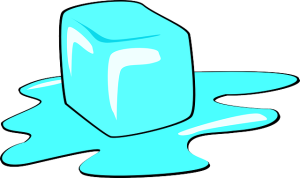Purpose
[stextbox id = “info”]To illustrate for students what they cannot see—that is, what happens at a particle level during phase change, in particular: that the number of particles does not change, that the size and shape of particles do not change, and that the particles are in constant motion.
[/stextbox]Description
[stextbox id = “info”]Teacher shows students the PhET simulation of states of matter https://phet.colorado.edu/en/simulation/states-of-matter-basics
[/stextbox]Questions to Ask Students
[stextbox id = “info”]To help students pay attention to the spacing of particles (i.e., there is empty space between them) and motion (i.e., particles are in constant random motion), ask such questions as:
- What do you notice about the motion of the particles?
- What do you notice about the space between the particles?
- What do you notice about the number of particles as the ice melts? Are there more particles? Fewer?
- What do you notice about the size of the particles as the ice melts? Do they change size?
- How does what you see in the simulation explain why the weight of the ice did not change when it melted?
Student Thinking
[stextbox id = “info”]The simulation confronts the following misconceptions:
- Matter is continuous (matter is actually particulate).
- The number of particles changes during phase changes (the number of particles actually stays the same).
- The size of particles changes during phase changes (the size of particles actually does not change).
- Particles in the solid state (ice) do not move (particles in the solid state actually move constantly).
Implementation Tips
[stextbox id = “info”]- Tell students that the simulation will allow them to see a model of what they cannot see, even with the strongest microscope.
- Spend some time with the simulation before you share it with your students. It allows you to adjust various settings, and being familiar with them will help.
- Recognize that the temperature shown in the simulation is in Kelvin. You can change to Celsius by clicking on the Teacher menu in the upper left-hand corner of the simulation. Or, to convert from Kelvin to degrees Celsius, subtract 273.
- Consider doing the simulation first with Argon or Neon instead of water. Argon and Neon have only one atom in their natural state and avoid the potential confusion that a water molecule (which has three atoms) presents.
- Begin in the solid phase. Focus students on the motion of the particles, the arrangement of the particles, and the space between the particles.
Stress for students the idea of empty space between particles in the simulation—that is, there is literally nothing (not even air) between the particles. - Move to the liquid phase. Again, focus students on the motion of the particles, their arrangement, and the space between them. Another important focus is the number of particles and that it stays the same in the solid and liquid phases.
- Students may ask how we know the model in the simulation is the right one. Models have to be supported by evidence, and one piece of evidence for the model in the simulation is that it explains why the weight didn’t change when the ice cube melted. Students can engage with other evidence for the model in other Driving Question Pathways.
